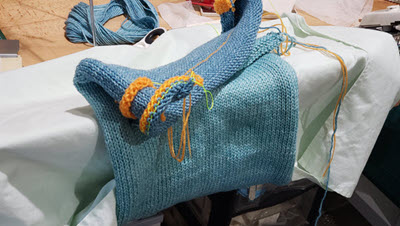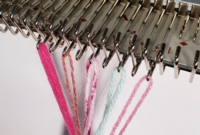Keep Your Knitting Safe During Breaks
Taking a break while machine knitting is totally normal, but it's important to take a few simple steps to keep your project safe.
Knitting long pieces on your machine requires extra care to prevent distortion, especially when left hanging on the needlebed for too long. The weight and tension needed for proper stitch formation can stretch or distort your stitches, and no one wants to deal with that frustration!
By protecting your knitting during breaks, you'll keep everything in great shape and finish your project without any surprises. Here's how to ensure beautiful results while resting.
Why Take Precautions?
Knitting stretched across the needlebed, combined with weights, can lead to distorted stitches if left unsupported. Taking a few simple steps will keep your stitches intact and prevent permanent issues.
Steps to Protect Your Knitting
- Record Your Progress - If you're working in a stitch pattern, note the row number of your design.
- Add a Lifeline (Optional) - Knit 1–2 rows of Waste Knitting to secure the knitting before pausing.
- Prepare the Needlebed - Pull all needles to the "D" or "E" position. Holding Position
- Remove Weights - Take off any weights to relieve tension on the stitches.
- Cover the Needlebed - Place a pillowcase or smooth fabric over the needlebed to prevent snagging.
- Support Your Knitting
- Option 1: Flip the knitting up and fold it gently over the needlebed and your knitting table.
- Option 2: Rest the knitting on a nearby chair to reduce the weight pulling on the stitches.
Resuming Your Knitting
- Unfold and Hang the Knitting - Let the knitting hang naturally from the needlebed.
- Remove the Waste Knitting (Optional) - If you added extra rows of waste yarn, remove them carefully.
- Reapply Weights - Rehang weights to ensure even tension.
- Restart Your Pattern - Resume your stitch pattern or design, confident your stitches are intact.
By taking these precautions, you'll protect your knitting from unnecessary strain and avoid distortion that could mar your work.
Ribber Knitting
When working on the ribber, it's even more critical to secure the stitches in work:
- Pull needles to the "D" or "E" position.
- Release the weights to take tension off the knitting.
- When resuming, reapply weight evenly to ensure proper stitch formation.
If your cast-on comb touches the floor, reposition it to maintain consistent weight and prevent stitches from slipping off.
For help with weights on the ribber, check out Tutorial: Ribber Weights on the Floor?
Want to learn more about ribber techniques and best practices? Visit our Ribber Classroom for detailed tutorials and guidance.
















